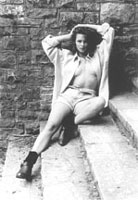Bergger BPF 200 Film And Prestige Paper
As French-made Bergger black
and white film and paper meet virtually every requirement of the exacting
large format worker, "Fine Materials for Fine Photography"
would also be a suitable title. Bergger BPF 200 film, available in a
wide range of standard and specialty sheet sizes, is a very close replacement
for Kodak's much-missed Super XX. Pair it with the dense blacks,
gentle tonal gradation, and thick base of Bergger Prestige, a line of
silver-rich papers able to hold their own against any premium offering
on the market, and you have a combo that impresses even those of us
who remember when Kodachrome came in red--or was it yellow--metal cans. |
|||
Designed by the former chief chemical engineer for Guilleminot and Boespflug of France, fiber-based Bergger Prestige paper is available in double weight, premium weight (300g/m2), and, with Prestige Silver Supreme, an extra premium weight (320g/m2) base. Except for Silver Supreme, these silver-rich papers are offered in neutral and warm tone, graded and VC, and in standard sizes from 8x10" to 20x24", including 12x16". Silver Supreme, produced only in 40x50cm and one (Normal) contrast grade, is coated on an exquisite 100 percent cotton rag base. Prestige NB is a double-weight glossy neutral-tone bromide paper, with Prestige NM having the same bartya-based emulsion in matte finish. Both are available in grades 1 to 4. Prestige Variable NB is a double-weight glossy neutral-tone VC paper that responds to Kodak and Ilford filters, or the corresponding values set on a dichroic or VC enlarger head. Prestige CB is a double-weight glossy warm-tone chloro-bromide paper, with CM having the same emulsion on premium-weight stock. Both are available in grades 2, 3, and 4. Prestige Variable CB (glossy) and CM (semimatte) are warm-tone premium-weight chloro-bromide VC papers, with Prestige Silver Su-preme's bromide emulsion giving a neutral, semimatte image. Prestige exposure times were a little on the long side, but the paper is by no means what I would call slow. I experienced some fogging with a yellow (OC) safelight, so I recommend taking the manufacturer's advice and using a red (1A) filter in a dim fixture. Of course, my original filter may have been defective, but I had no further trouble with a 1A in the same unit. Almost any developer works well, but I found 21/2 minutes to be a good starting point in Dektol 1+2 with graded and VC versions. Two minutes in 1+40 selenium gives the image a nice, gentle tone, but the possibilities are almost endless by varying toner dilution and/or treatment time. Finding the words to describe a good image is like finding ones to characterize a fine wine, but to put it simply, Prestige is an exquisite paper. The blacks are bold, the base is bright, and the image possesses a unique "depth" that is seldom seen today. While I can't yet defend this with facts and figures, I believe it is simply the "old" design of its emulsion--the absence of brighteners, topcoats, incorporated developing agents, and other additions common to "new" papers--that gives Prestige this distinctive quality. Prestige paper and BPF 200 film are fine traditional materials for the discerning photographer who, young or old, can savor the visual feast offered only by a meticulously executed black and white photograph. Bergger products, along with the Lotus line of view cameras and large format accessories (see our review of the Lotus View Rapid Field camera in the July, 1999 issue), are distributed by Lotus View Camera/North America, 5955 Palo Verde Dr., Rockford, IL 61114; (815) 282-9876; fax: (815) 282-0902; e-mail: viewcam@wwa.com or web site at: www.lotusviewcamera.at/. |
- Log in or register to post comments



































